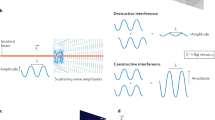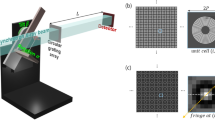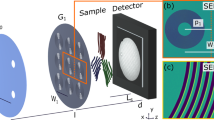Abstract
The mechanical properties of many materials are based on the macroscopic arrangement and orientation of their nanostructure. This nanostructure can be ordered over a range of length scales. In biology, the principle of hierarchical ordering is often used to maximize functionality, such as strength and robustness of the material, while minimizing weight and energy cost. Methods for nanoscale imaging provide direct visual access to the ultrastructure (nanoscale structure that is too small to be imaged using light microscopy), but the field of view is limited and does not easily allow a full correlative study of changes in the ultrastructure over a macroscopic sample. Other methods of probing ultrastructure ordering, such as small-angle scattering of X-rays or neutrons, can be applied to macroscopic samples; however, these scattering methods remain constrained to two-dimensional specimens1,2,3,4 or to isotropically oriented ultrastructures5,6,7. These constraints limit the use of these methods for studying nanostructures with more complex orientation patterns, which are abundant in nature and materials science. Here, we introduce an imaging method that combines small-angle scattering with tensor tomography to probe nanoscale structures in three-dimensional macroscopic samples in a non-destructive way. We demonstrate the method by measuring the main orientation and the degree of orientation of nanoscale mineralized collagen fibrils in a human trabecula bone sample with a spatial resolution of 25 micrometres. Symmetries within the sample, such as the cylindrical symmetry commonly observed for mineralized collagen fibrils in bone8,9,10, allow for tractable sampling requirements and numerical efficiency. Small-angle scattering tensor tomography is applicable to both biological and materials science specimens, and may be useful for understanding and characterizing smart or bio-inspired materials. Moreover, because the method is non-destructive, it is appropriate for in situ measurements and allows, for example, the role of ultrastructure in the mechanical response of a biological tissue or manufactured material to be studied.
This is a preview of subscription content, access via your institution
Access options
Subscribe to this journal
Receive 51 print issues and online access
$199.00 per year
only $3.90 per issue
Buy this article
- Purchase on Springer Link
- Instant access to full article PDF
Prices may be subject to local taxes which are calculated during checkout



Similar content being viewed by others
References
Fratzl, P., Jakob, H. F., Rinnerthaler, S., Roschger, P. & Klaushofer, K. Position-resolved small-angle X-ray scattering of complex biological materials. J. Appl. Cryst. 30, 765–769 (1997)
Rinnerthaler, S. et al. Scanning small angle X-ray scattering analysis of human bone sections. Calcif. Tissue Int. 64, 422–429 (1999)
Bunk, O. et al. Multimodal x-ray scatter imaging. New J. Phys. 11, 123086 (2009)
Georgiadis, M. et al. 3D scanning SAXS: a novel method for the assessment of bone ultrastructure orientation. Bone 71, 42–52 (2015)
Jensen, T. H. et al. Molecular X-ray computed tomography of myelin in a rat brain. Neuroimage 57, 124–129 (2011)
Schroer, C. G. et al. Mapping the local nanostructure inside a specimen by tomographic small-angle x-ray scattering. Appl. Phys. Lett. 88, 164102 (2006)
Álvarez-Murga, M., Bleuet, P. & Hodeau, J.-L. Diffraction/scattering computed tomography for three-dimensional characterization of multi-phase crystalline and amorphous materials. J. Appl. Cryst. 45, 1109–1124 (2012)
Seidel, R. et al. Synchrotron 3D SAXS analysis of bone nanostructure. Bioinspir. Biomim. Nanobiomater . 1, 123–131 (2012)
Giannini, C. et al. Scanning SAXS–WAXS microscopy on osteoarthritis-affected bone – an age-related study. J. Appl. Cryst. 47, 110–117 (2014)
Pabisch, S., Wagermaier, W., Zander, T., Li, C. H. & Fratzl, P. in Methods in Enzymology Vol. 532 (ed. De Yoreo, J. J. ) 391–413 (Elsevier, 2013)
Currey, J. D. Bones: Structure and Mechanics (Princeton Univ. Press, 2002)
Fratzl, P. & Weinkamer, R. Nature’s hierarchical materials. Prog. Mater. Sci. 52, 1263–1334 (2007)
Schneider, P., Meier, M., Wepf, R. & Muller, R. Towards quantitative 3D imaging of the osteocyte lacuno-canalicular network. Bone 47, 848–858 (2010)
Holler, M. et al. X-ray ptychographic computed tomography at 16 nm isotropic 3D resolution. Sci. Rep. 4, 3857 (2014)
Martin, R. B. & Ishida, J. The relative effects of collagen fiber orientation, porosity, density, and mineralization on bone strength. J. Biomech. 22, 419–426 (1989)
Riggs, C. M., Vaughan, L. C., Evans, G. P., Lanyon, L. E. & Boyde, A. Mechanical implications of collagen fibre orientation in cortical bone of the equine radius. Anat. Embryol. 187, 239–248 (1993)
Granke, M. et al. Microfibril orientation dominates the microelastic properties of human bone tissue at the lamellar length scale. PLoS ONE 8, e58043 (2013)
Giannini, C. et al. Correlative light and scanning X-ray scattering microscopy of healthy and pathologic human bone sections. Sci. Rep. 2, 435 (2012)
Zhao, Q. & Wagner, H. D. Raman spectroscopy of carbon-nanotube-based composites. Phil. Trans. R. Soc. London Ser. A 362, 2407–2424 (2004)
Bi, X., Li, G., Doty, S. B. & Camacho, N. P. A novel method for determination of collagen orientation in cartilage by Fourier transform infrared imaging spectroscopy (FT-IRIS). Osteoarthr. Cartilage 13, 1050–1058 (2005)
Rauch, E. F. et al. Automated nanocrystal orientation and phase mapping in the transmission electron microscope on the basis of precession electron diffraction. Z. Krist . 225, 103–109 (2010)
Heidelbach, F., Riekel, C. & Wenk, H.-R. Quantitative texture analysis of small domains with synchrotron radiation X-rays. J. Appl. Cryst. 32, 841–849 (1999)
Feldkamp, J. M. et al. Recent developments in tomographic small-angle X-ray scattering. Phys. Status Solidi A 206, 1723–1726 (2009)
Ludwig, W., Schmidt, S., Lauridsen, E. M. & Poulsen, H. F. X-ray diffraction contrast tomography: a novel technique for three-dimensional grain mapping of polycrystals. I. Direct beam case. J. Appl. Cryst. 41, 302–309 (2008)
Basser, P. J., Mattiello, J. & Lebihan, D. Estimation of the effective self-diffusion tensor from the NMR spin echo. J. Magn. Reson. B . 103, 247–254 (1994)
Malecki, A. et al. X-ray tensor tomography. EPL (Europhys. Lett.) 105, 38002 (2014)
Gourrier, A. et al. Scanning small-angle X-ray scattering analysis of the size and organization of the mineral nanoparticles in fluorotic bone using a stack of cards model. J. Appl. Cryst. 43, 1385–1392 (2010)
Roe, R. J. Description of crystallite orientation in polycrystalline materials. III. General solution to pole figure inversion. J. Appl. Phys. 36, 2024–2031 (1965)
Bunge, H. J. & Roberts, W. T. Orientation distribution, elastic and plastic anisotropy in stabilized steel sheet. J. Appl. Cryst. 2, 116–128 (1969)
Jensen, T. H. et al. Brain tumor imaging using small-angle x-ray scattering tomography. Phys. Med. Biol. 56, 1717–1726 (2011)
Kraft, P. et al. Performance of single-photon-counting PILATUS detector modules. J. Synchrotron Radiat. 16, 368–375 (2009)
Howells, M. R. et al. An assessment of the resolution limitation due to radiation-damage in X-ray diffraction microscopy. J. Electron Spectrosc . 170, 4–12 (2009)
Hubbell, J. & Seltzer, M. Tables of X-ray Mass Attenuation Coefficients and Mass Energy-Absorption Coefficients Version 1.4. Report No. NISTIR--5632 (National Institute of Standards and Technology, 1995); http://physics.nist.gov/xaamdi
Tinti, G., et al. Performance of the EIGER single photon counting detector. J. Instrum. 10, C03011 (2015)
Guizar-Sicairos, M., Thurman, S. T. & Fienup, J. R. Efficient subpixel image registration algorithms. Opt. Lett. 33, 156–158 (2008)
Thibault, P. & Guizar-Sicairos, M. Maximum-likelihood refinement for coherent diffractive imaging. New J. Phys. 14, 063004 (2012)
Grenander, U. Abstract Inference Ch. 9 (Wiley, 1981)
Acknowledgements
We thank M. Holler and J. Raabe for their help in sample preparation and A. Diaz, F. Schaff and M. Bech for discussions. M.G. was supported by the ETH Research Grant ETH-39 11-1. The vertebral specimen was provided by W. Schmölz, Department for Trauma Surgery, Innsbruck Medical University, Innsbruck, Austria.
Author information
Authors and Affiliations
Contributions
M.L., M.G., A.M., P.S., O.B., and M.G.-S. conceived the research project. M.G. prepared the sample. M.L., M.G., and M.G.-S. carried out the X-ray experiments. M.L. developed the data analysis framework with support from O.B. and M.G.-S. Results were interpreted by M.L., M.G., P.S., and J.K. M.L. wrote the manuscript with contributions from all authors.
Corresponding authors
Ethics declarations
Competing interests
The authors declare no competing financial interests.
Supplementary information
3D reconstruction of the small-angle scattering tensor tomography
Orientation of bone ultrastructure as retrieved from small-angle scattering (SAS) tensor tomography. The cylinder orientation represents the main orientation of collagen fibrils in the corresponding voxel. The degree of orientation is represented by both colour and length of the cylinders, where a low degree of orientation (blue) means low ordering of the collagen fibrils, while in regions with a high degree of orientation (red) the collagen fibrils are well aligned with respect to each other. (MOV 4386 kb)
Rights and permissions
About this article
Cite this article
Liebi, M., Georgiadis, M., Menzel, A. et al. Nanostructure surveys of macroscopic specimens by small-angle scattering tensor tomography. Nature 527, 349–352 (2015). https://doi.org/10.1038/nature16056
Received:
Accepted:
Published:
Issue Date:
DOI: https://doi.org/10.1038/nature16056
This article is cited by
-
Unveiling breast cancer metastasis through an advanced X-ray imaging approach
Scientific Reports (2024)
-
Time-resolved ultra-small-angle X-ray scattering beamline (BL10U1) at SSRF
Nuclear Science and Techniques (2024)
-
Occlusive membranes for guided regeneration of inflamed tissue defects
Nature Communications (2023)
-
A machine learning model for textured X-ray scattering and diffraction image denoising
npj Computational Materials (2023)
-
Small-angle X-ray and neutron scattering
Nature Reviews Methods Primers (2021)
Comments
By submitting a comment you agree to abide by our Terms and Community Guidelines. If you find something abusive or that does not comply with our terms or guidelines please flag it as inappropriate.



